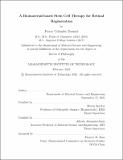| dc.description.abstract | Retinal diseases such as age-related macular degeneration and diabetic retinopathy are the leading cause of blindness worldwide with prevalence and resulting costs projected to increase. There are few available treatments, and their applicability is limited to slowing down the degeneration of the retina resulting from these diseases. New treatments are needed to either stop the degeneration or regenerate the retina with healthy cells to improve vision. Emerging therapies, in clinical trials, are investigating stem cell-derived photoreceptors injected, in a saline solution, into the subretinal space to replace dying cells caused by retinal degeneration.
The principal objectives of this thesis were to engineer a bio-inspired injectable matrix to incorporate stem cell-derived retinal cells and growth factors (viz., epidermal growth factor) for injection into the subretinal space or vitreous, in place of saline, and to evaluate the ability of the gel therapy to increase the viability, engraftment, and functionality of the exogeneous cells in the retina. To achieve this goal, we employed conjugates of gelatin with hydroxyphenyl propionic acid, an amino acid-like molecule (Gtn-HPA), and hyaluronic acid with tyramine (HA-Tyr). We also investigated an interpenetrating network (IPN) comprising a combination of Gtn-HPA and HA-Tyr, which can be tuned to obtain the optimal mechanical, chemical, and injectable characteristics tailored to improve retinal regeneration. The effects of these hydrogels on various retinal cells (human ganglion cells, human retinal progenitors, and human cones photoreceptors) were analyzed in the in vitro setting and showed positive results: high viability, controlled differentiation, and low apoptosis.
In the first of 3 application-based in vivo experiments, we investigated select hydrogels incorporating specific cell types to treat problems associated with retinal ganglion cells (RGCs) in vitreous injections. Transplanted RGCs showed significantly higher engraftment and process extension when encapsulated in our IPN compared to saline injections.
In a second in vivo experiment, we transplanted retinal progenitor cells (hRPCs) in the subretinal space environment to address problems associated with photoreceptors in the retina. Transplantations were quantified and compared to injections in saline at 1- and 3-weeks post-transplantation. At both time points, a 5-fold increase in engrafted hRPCs in the outer nuclear layer (ONL) was observed when the cells were injected in our biomaterial compared to injection in saline.
In a third vivo experiment, a novel human cone progenitor (hCP) cell line was created and studied in retinal degenerative animal models (such as RCS rats and RD1 mice). hCPs were found to engraft in high numbers and showed a significant 2-fold increase in retinal functionality, which was measured with optokinetic (OKN) and electroretinogram (ERG) assays. The results of this thesis motivate and guide further translational study in a large animal model to validate Gtn-HPA/HA-Tyr hydrogels incorporating retinal stem cells and growth factors for the promotion of retinal regeneration in a larger eyeball size with the attendant improvement in visual function. | |
